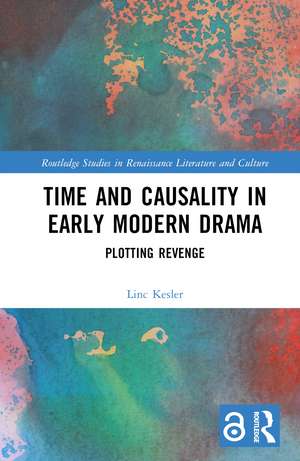Time and Causality in Early Modern Drama: Plotting Revenge: Routledge Studies in Renaissance Literature and Culture
Autor Linc Kesleren Limba Engleză Hardback – 7 iun 2024
The Open Access version of this book, available at http://www.taylorfrancis.com, has been made available under a Creative Commons [Attribution-Non Commercial-No Derivatives (CC-BY-NC-ND)] 4.0 license.
Din seria Routledge Studies in Renaissance Literature and Culture
-
 Preț: 311.41 lei
Preț: 311.41 lei -
 Preț: 714.57 lei
Preț: 714.57 lei -
 Preț: 310.43 lei
Preț: 310.43 lei -
 Preț: 485.40 lei
Preț: 485.40 lei -
 Preț: 339.87 lei
Preț: 339.87 lei -
 Preț: 453.12 lei
Preț: 453.12 lei - 18%
 Preț: 1053.16 lei
Preț: 1053.16 lei -
 Preț: 443.65 lei
Preț: 443.65 lei - 18%
 Preț: 1001.90 lei
Preț: 1001.90 lei - 18%
 Preț: 1110.77 lei
Preț: 1110.77 lei -
 Preț: 282.95 lei
Preț: 282.95 lei - 18%
 Preț: 1109.18 lei
Preț: 1109.18 lei - 18%
 Preț: 1053.16 lei
Preț: 1053.16 lei -
 Preț: 389.38 lei
Preț: 389.38 lei - 26%
 Preț: 763.78 lei
Preț: 763.78 lei -
 Preț: 440.97 lei
Preț: 440.97 lei - 26%
 Preț: 764.62 lei
Preț: 764.62 lei - 13%
 Preț: 321.08 lei
Preț: 321.08 lei - 26%
 Preț: 765.01 lei
Preț: 765.01 lei -
 Preț: 433.26 lei
Preț: 433.26 lei - 18%
 Preț: 1062.26 lei
Preț: 1062.26 lei - 18%
 Preț: 1115.69 lei
Preț: 1115.69 lei - 18%
 Preț: 1106.81 lei
Preț: 1106.81 lei - 18%
 Preț: 1057.09 lei
Preț: 1057.09 lei - 18%
 Preț: 1061.22 lei
Preț: 1061.22 lei - 18%
 Preț: 1138.65 lei
Preț: 1138.65 lei -
 Preț: 387.49 lei
Preț: 387.49 lei - 18%
 Preț: 1053.92 lei
Preț: 1053.92 lei -
 Preț: 493.80 lei
Preț: 493.80 lei - 26%
 Preț: 762.57 lei
Preț: 762.57 lei -
 Preț: 416.22 lei
Preț: 416.22 lei - 18%
 Preț: 1111.55 lei
Preț: 1111.55 lei - 18%
 Preț: 1040.35 lei
Preț: 1040.35 lei - 18%
 Preț: 1000.27 lei
Preț: 1000.27 lei - 26%
 Preț: 847.73 lei
Preț: 847.73 lei - 26%
 Preț: 849.48 lei
Preț: 849.48 lei - 18%
 Preț: 1055.51 lei
Preț: 1055.51 lei - 18%
 Preț: 1050.09 lei
Preț: 1050.09 lei - 26%
 Preț: 765.77 lei
Preț: 765.77 lei
Preț: 1000.27 lei
Preț vechi: 1219.84 lei
-18% Nou
Puncte Express: 1500
Preț estimativ în valută:
191.41€ • 197.77$ • 159.23£
191.41€ • 197.77$ • 159.23£
Carte tipărită la comandă
Livrare economică 19 martie-02 aprilie
Preluare comenzi: 021 569.72.76
Specificații
ISBN-13: 9781032721934
ISBN-10: 1032721936
Pagini: 226
Ilustrații: 4
Dimensiuni: 152 x 229 x 14 mm
Greutate: 0.48 kg
Ediția:1
Editura: Taylor & Francis
Colecția Routledge
Seria Routledge Studies in Renaissance Literature and Culture
Locul publicării:Oxford, United Kingdom
ISBN-10: 1032721936
Pagini: 226
Ilustrații: 4
Dimensiuni: 152 x 229 x 14 mm
Greutate: 0.48 kg
Ediția:1
Editura: Taylor & Francis
Colecția Routledge
Seria Routledge Studies in Renaissance Literature and Culture
Locul publicării:Oxford, United Kingdom
Public țintă
PostgraduateCuprins
Acknowledgements
Introduction
Part I, A Theory of Tragedy
1 Nietzsche, Aristotle, and a Theory of Tragedy
Part II, Precursors To Tragedy
2 Epics and Narratives of Inclusion
3 “The Syllables of Time”: Drama and Time in the Middle Ages
Part III, Tragedy, Time, and Revenge
4 Marlowe’s “Tragic Glass” and the Decline of Analogy
5 The Spanish Tragedy and Revenge
6 Titus Andronicus
7 Hamlet
8 Othello
9 Decadent Tragedy
Part IV, Reflections on Process
10 Epilogue and Conclusions
Bibliography
Index
Introduction
Part I, A Theory of Tragedy
1 Nietzsche, Aristotle, and a Theory of Tragedy
Part II, Precursors To Tragedy
2 Epics and Narratives of Inclusion
3 “The Syllables of Time”: Drama and Time in the Middle Ages
Part III, Tragedy, Time, and Revenge
4 Marlowe’s “Tragic Glass” and the Decline of Analogy
5 The Spanish Tragedy and Revenge
6 Titus Andronicus
7 Hamlet
8 Othello
9 Decadent Tragedy
Part IV, Reflections on Process
10 Epilogue and Conclusions
Bibliography
Index
Notă biografică
Linc Kesler has a B.A. from Yale University and a Ph.D. from The University of Toronto, both in English literature. He is now an emeritus professor at the University of British Columbia. In his early career he taught early modern English literature and literary theory at Oregon State University, while also leading the establishment of the state’s first Ethnic Studies department and other services for American Indian and other under-represented students and working on oral history and other projects with Oregon tribal organizations. In 2003 he became the first director of First Nations and Indigenous Studies at UBC, developing curriculum centred on research partnerships with Indigenous communities and organizations and advanced uses of digital technologies. He subsequently became the director of the First Nations House of Learning and senior advisor to the president on Aboriginal Affairs, leading the development and implementation of the UBC Aboriginal Strategic Plan and the establishment of units such as the Indian Residential School History and Dialogue Centre, the Centre for Excellence in Indigenous Health, and the Indigenous Research Support Initiative. Since leaving teaching and administration, he has returned to research on early modern English drama. His Indigenous ancestry is Oglala Lakota from the Pine Ridge Indian reservation in South Dakota.
Descriere
The opening of the first theatre in 1579 created an interplay between the innovations of producers and the perceptions of orally-conditioned audiences. Located in the context of relations between the academy and Indigenous communities, this work questions our abilities, habituated to literacy, to understand oral systems.
